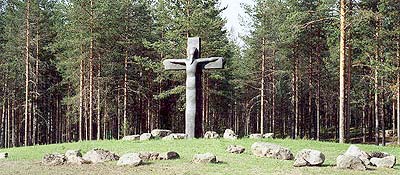Cross of SorrowA Memorial Complex ”Cross of Sorrow”, dedicated to the victims of the Soviet-Finnish Winter War (1939-1940) was unveiled several kilometers off Pitkäranta at the road fork to Petrozavodsk and Suojärvi in July 27-th 2000. In November 30-th 1939 huge motorized forces of the Soviet 8-th army under the command of division general I.Khabarov (since December 4-th – brigade general V.Kurdyumov and after January 10-th – army general G.Shtern) invaded Finland, moving along the shores of Ladoga Lake towards Sortavala. Capture of Sortavala was the aim of the first week of the offensive. But burdened by heavy arms and transports and bound to the few winter roads soviet troops met with the excellence of the personal training of Finnish army. Performing the classical encircle tactics in December 26th Finnish IVth army corps under command of Major General Juhan Woldemar Hägglund has blocked 18th Jaroslavl division (under command of brigade general G.Kondrashov) and 34th Kalinovsky tank brigade (under command of brigade general S.Kondrat'ev) in the northwest of Pitkäranta and broke them into 13 separate encirclements (motti). Biggest of them – so called "general's encirclement" – with high command of encircled troops – was around the road fork to Petrozavodsk and Suojärvi. During January-February the encircled troops were methodically liquidated by Finnish army. During the night from 28th to 29th February in the attempt to break the encirclement the garrison of the last – the "general's encirclement" – was almost totally killed. Finns took the color of 18th division and huge trophies. During the battle were killed nearly 6 thousands of Finnish solders and more than 35 thousands of Soviet ones. The decision to erect the monument was taken in November 1992 in accord with 11th July 1992 The agreement between the Government of Russian Federation and the Government of the Republic of Finland about memorizing the soldiers, Russian (Soviet) – in Finland and Finnish – in Russia, that were killed during the Second World War. International open competition for the project of the monument, held in 1993, gathered 14 participants. In February 1st the results were announced. Well-known Petrozavodsk sculptor, Academician of the Russian Academy of Arts Leo Lankinen, who proposed the monument in the form of cross, on opposite sides of which were presented two sisters, two mothers – Russia and Finland – in sorrow for the dead, became the winner. The idea of the monument was expressed by Leo Lankinen in his poem: Russia and Finland – two sisters.
Finland and Russia – two mothers. They are embodied in this Cross of Sorrow.By themselves. Their heads have merged as one, their hands have joined in Hope, that love might be victorious.And this depends on us. On every one of us.In 1995 Leo Lankinen made a 1/3 scale model of the monument. Full-size model (5 meters high) was completed by the sculptor Eduard Akulov with the participation of his children Alexander Akulov and Olga Rakitskaya in 1998 after the death of Leo Lankinen. In the winter of 1999-2000 the monument was made of cast iron at the Petrozavodskmash plant. The control over the casting and post-casting processing of the sculpture was performed by sculptor Alexander Akulov. At the same time, a landscape solution of the Cross of Sorrow was developed. As early as the summer of 1994, Leo Lankinen and Petrozavodsk architect Lia Karma chose a location for a monument. In 1995, Lia Karma designed the project of the Cross of Sorrow Memorial Complex. In 1999-2000, the project was finalized and implemented by architects Lia Karma and Vyacheslav Shevlyakov. The construction of the complex was carried out by the Pitkäranta Building and Construction Department under the leadership of Nikolay Petrov in April-June 2000. The Cross of Sorrow Memorial Complex awarded by the 3rd prize at the All-Russian Architectural Contest of the Best Architectural Works of 1998-2000. Since the end of 1995 a public committee, headed by Terttu Vilponen-Salmela, aimed to support the woks on erection of the monument, worked in the Finnish town Kuopio. Works on the monument were financed by the Russian Federation Ministry of Culture, Kuopio municipality and private donations. |
